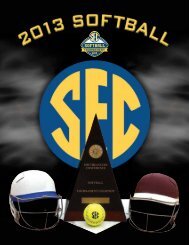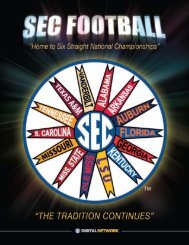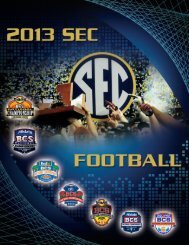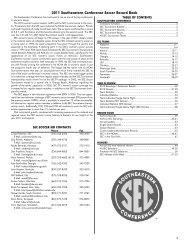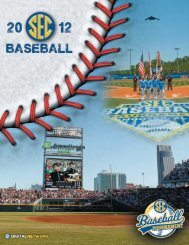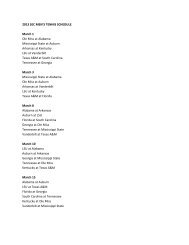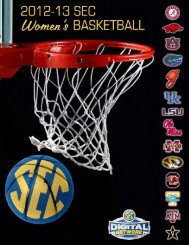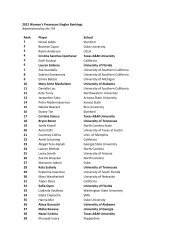SEC Constitution and Bylaws - Southeastern Conference
SEC Constitution and Bylaws - Southeastern Conference
SEC Constitution and Bylaws - Southeastern Conference
You also want an ePaper? Increase the reach of your titles
YUMPU automatically turns print PDFs into web optimized ePapers that Google loves.
institutional financial aid that is not from an athletics source <strong>and</strong> is based on financial need only, consistentwith institutional regulations. [Revised 6/1/95; Revised 6/1/08; effective 8/1/08](b)(c)A limited number (see limits in subsection 14.3.2.1(c) below) of student-athletes who enroll at a memberinstitution as freshmen or as 4-4 transfer students <strong>and</strong> who are non-qualifiers (or were non-qualifiers at thetime of their original enrollment in college) may become eligible for athletically-related financial aid,practice, <strong>and</strong> competition after their freshman year. Student-athletes who enroll at a member institution asfreshman may become eligible for athletically related financial aid, practice, <strong>and</strong> competition after theirfreshman year, provided that (i) each such student presents an average high school GPA of at least 2.0 (asconfirmed <strong>and</strong> certified by the NCAA Eligibility Center) in at least twelve core courses, <strong>and</strong> (ii) theCommissioner issues a favorable determination with respect to such student in accordance with theprocedures set forth in subsection 14.3.2.1(g) below. Even though such non-qualifier may not receiveathletically-related financial aid, the non-qualifier shall count in the institution’s overall team financial aidlimits. In equivalency sports, such non-qualifier shall count as one-half of a full athletic grant-in-aid thefirst year; in subsequent years, the actual grant-in-aid value shall count. 4-4 transfer students who werenon-qualifiers at the time of their original enrollment in college may become eligible for athletically relatedfinancial aid, practice, <strong>and</strong> competition after their freshman year, provided that each such student meets therequirements of <strong>SEC</strong> Bylaw 14.5.5.6. [Revised 6/1/96 effective June 1, 1997 for those student-athletes firstentering a member institution on or after Fall semester/quarter, 1997; Revised 6/1/08; effective 8/1/2008]There shall be an annual limit on the number of student-athletes who are non-qualifiers <strong>and</strong> who maybecome eligible after their freshman year for athletically-related financial aid, practice, <strong>and</strong> competition,whether such student-athletes are enrolled as freshmen or as 4-4 transfer students. (These limits do notapply to two-year college transfer students, see Bylaw 14.5.4.2.) The limits, which are applied on anannual basis with no carry-over of unused numbers to following years, are set forth as follows: [Adopted6/5/99; revised 5/30/03; Revised 6/1/08; effective 8/1/2008]For men’s sports a total of four non-qualifiers enrolled in a particular academic year (either as first yearstudents or 4-4 transfers) may become eligible to receive athletically-related financial aid, or for practice orcompetition. Of these four, no more than two are permitted to become eligible in football, <strong>and</strong> no morethan one may become eligible in any other sport.For women’s sports, a total of four non-qualifiers enrolled in a particular academic year (either as first yearstudents or 4-4 transfers) may become eligible to receive athletically-related financial aid, or for practice orcompetition. Of these four, no more than one may become eligible in any one sport. [Revised 5/30/03effective 8/1/2003](d)(e)(f)The annual limits set forth in subsection 14.3.2.1 (c) shall not apply to any student-athlete who has beencertified by the NCAA as learning disabled <strong>and</strong> who is otherwise eligible hereunder. [Adopted 6/5/99]In the event that a member institution enrolls a student-athlete as a freshman who is a non-qualifier <strong>and</strong>who does not present an average high school GPA of at least 2.0 (as confirmed <strong>and</strong> certified by the NCAAEligibility Center) in at least twelve core courses, or in the event that the Commissioner issues anunfavorable determination with respect to any such student in accordance with the procedures set forth insubsection 14.3.2.1(g) below, such student may never become eligible for athletically-related financial aid,or for practice or competition, at such institution. Before enrolling a student who may be affected by thisBylaw 14.3.2.1(e), the member institution should inform the student that <strong>SEC</strong> Bylaw 14.5 may afford thestudent a path to possible eligibility, in the event, for example, that the student chooses to attend a two yearcollege. If <strong>and</strong> to the extent otherwise allowed by NCAA <strong>Bylaws</strong>, a transfer student from a two yearcollege may be eligible for athletically-related financial aid, practice, <strong>and</strong> competition for up to four years.[Adopted 6/1/08]Prospective student-athletes with disabilities are subject to <strong>and</strong> must satisfy the eligibility st<strong>and</strong>ards setforth in this Bylaw 14.3.2.1; provided, however, that (i) in satisfying such st<strong>and</strong>ards, such students maytake advantage of NCAA <strong>Bylaws</strong> 14.3.1.2.1.2 <strong>and</strong> 14.3.1.2.5, <strong>and</strong> any other applicable NCAA or <strong>SEC</strong><strong>Bylaws</strong> that have the purpose or effect of providing reasonable accommodation to disabled individuals, <strong>and</strong>21





